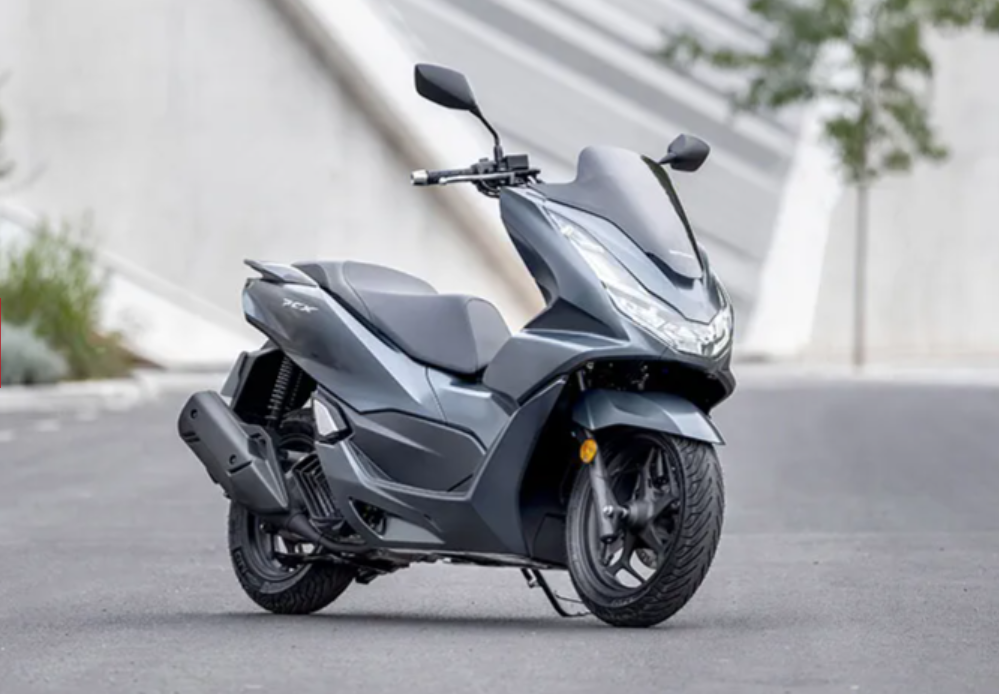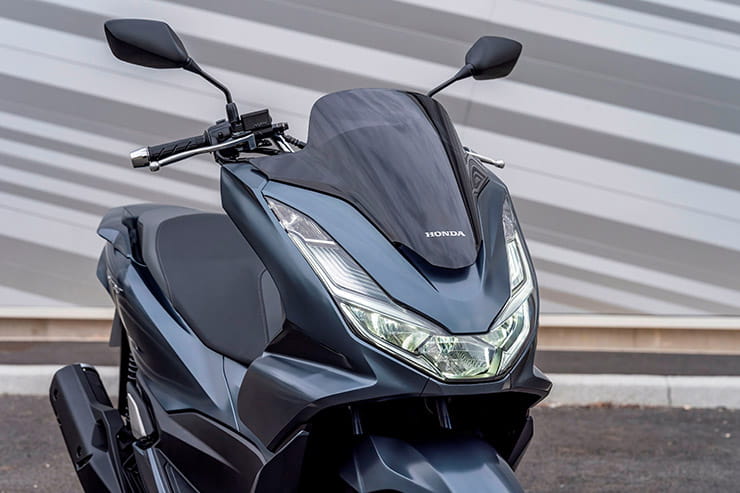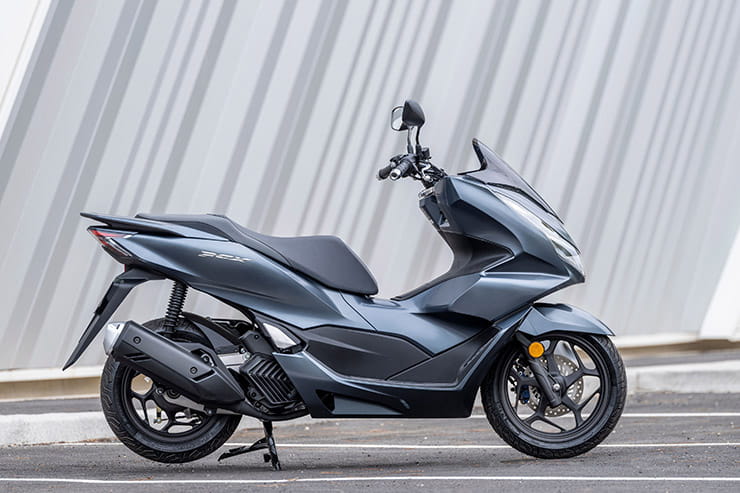Honda’s PCX 125 has been the best-selling bike in Britain for a number of years but, faced with ever stiffer competition from the likes of Yamaha’s NMAX and low-cost Chinese imports, has been updated for 2021. At first glance, the new bike doesn’t look much different, but we all know looks can be deceiving, so we compared it directly to the outgoing 2020 model to see how much of an update it really has received.

Power and torque
Power is up fractionally for 2021 with the revised ESP+ engine making an extra 0.2kW(0.268bhp) over the previous generation ESP engine, but the key difference is that it’s made higher in the rev range at 8750rpm compared to 8500rpm for the previous model. Is this extra power noticeable on the road though?
Around town the improved pick up off the line is better and torque figures make it better through the rev range.
I suspect that the majority of the difference in performance it not down to the engine changes alone as, as with any CVT system, performance characteristics can be altered by changing roller weights (lighter rollers allow the engine to spin up higher before engaging) allowing the bike to make the most of any altered engine characteristics. (A quick check of Honda part numbers does indeed confirm that the rollers have different part numbers between the years).
Engine, gearbox and exhaust
For 2021, the PCX is equipped with Honda’s next generation eSP+ engine – a fully Euro5 compliant unit which achieves the higher emissions legislation by adopting a four-valve head in place of the previous engine’s two-valve configuration. The engine bore and stroke have also been changed, enlarging the bore (improving fuel efficiency and torque), while reducing the stroke (allowing the engine to rev higher). Air intake and exhaust have also been optimised for air flow and efficiency.
On the road, the differences between the two bike’s engines were very subtle, but noticeable. Jumping from one bike to the other, there was a definite improvement in drive – not night and day, but enough to be noticeable with the 2021 bike feeling less stressed when maintaining high speeds and pulling away from the lights a little quicker.
We both noticed a difference in exhaust note, which, to be honest, made the 2021 model sound a bit ‘tinny’. The new bike carries a completely redesigned exhaust with a much slimmer profile, but after a few hours on the road, we both preferred the sound of Gavin’s 2019 model.
2021 Honda PCX125 Economy
Economy has always been a selling point for scooters of all sizes, with figures in excess of 100mpg the norm in this class, and the 2021 PCX125 continues this with a claimed average consumption figure of 134.5mpg without use of the Stop/Start feature.
While a series of heavy-handed test rides is never an ideal way to test everyday fuel consumption, we managed similar figures of around 105mpg on the 2021 model. Even with fuel prices at a long-term high and a full tank costing around £10, the Honda makes sound financial sense for low-cost commuting.
One update we did notice in the petrol station is the addition of a small holder on the underside of the fuel filler flap, which allows the quick and easy stowage of the fuel cap – a nice touch and one that I am sure will be welcomed by owners.
Handling, suspension, chassis and weight
While the forks have been carried over from the outgoing model to the new 2021 bike, the rear suspension has received an overhaul with longer stroke shocks, taking the rear travel from 84mm to 95mm, despite keeping the seat height the same at 764mm.
The chassis has also received a slight tweak from the previous model with the trail being tightened to 80mm from 86mm, quickening the steering slightly.
On the road, these slight changes were surprisingly evident with the new bike feeling both quicker to steer without being flighty, and smoother on Peterborough’s less-than-billiard table-like roads.
“The new bike felt much more agile in the turns, but more stable on faster roads and around roundabouts. It’s really confidence inspiring.” was Gavin’s first reaction, and I agree – the new bike is a step change up from the old one.
Handling is further helped by the new wheels which, while staying at 14″ diameter up front, change to 13″ at the rear and gain some width, now being fitted with Michelin City Grip 110/70 tyres up front and 130/70s on the back (previously 100/80 and 120/70).
2021 Honda PCX125 Brakes
Perhaps the biggest area where the PCX is starting to a bit long in the tooth, and yet surprisingly hasn’t been updated, is in the braking department.
While competitors such as the Yamaha NMAX have discs all round, Honda has continued to fit the PCX with a rear drum. While this works adequately given the speed and weight of the bike, it does mean that there’s also no ABS at the back meaning that grabbing a handful of rear will result in a locked wheel and associated squealing. Once the infantile enjoyment of skidding up to every set of lights has waned (it took a while for me), it also means that periodic adjustment of the rear brake is necessary to maintain optimum braking force.
Don’t get me wrong, both the outgoing and incoming models of PCX have more than enough braking to safely stop in a variety of conditions, especially with the excellent linked front brake system, but to keep up with the Joneses, I would think this will be the next area of improvement when the model received its next update.
Comfort over distance and touring
The old adage of ‘if it isn’t broken, don’t fix it’ certainly holds true with the PCX and, as you would expect for such an update, the overall riding position, comfort and riding experience is pretty similar between both bikes. This is a good thing if you get on with the current bike (it seems to be one-size-fits-all already with quite a difference between me and Gavin, but with both of us finding the bike comfortable), but bad news if you find the PCX a little cramped around the legs (particularly tall riders).
The updated screen, despite only a minor change, actually provides a significant improvement in the reduction of airflow to the rider, particularly around the hands – which will be welcome by all.
While our test ride wasn’t exactly a full day in the saddle, right from the off, the riding position is comfortable and relaxed with enough room, both on the seat, and around the footboards, to allow a good range of positions to avoid fatigue.
Rider aids and extra equipment / accessories
The rider aids are where Honda has more obviously splashed the cash with the new model with the addition of keyless ignition, switchable traction7 control, updated LED lights, USB charging points and a larger storage cubby under the seat. Honda has obviously been listening to their customer base and tried to accommodate the finer points that city riders, and more importantly, delivery riders want from the bike.
The underseat cubby is a massive improvement over the outgoing bike, with the reduction of the stepped floor of the old model meaning much more usable space. You may need to still choose your helmet carefully though as, while my chinless Jet helmet fitted well, a more bulky and vented full face helmet might struggle.
2021 Honda PCX125 verdict
The PCX is still a great bike, made even better in its 2021 guise. Should you go out and trade up your 2019 models? Well, yes and no. If you are coming to the end of your PCP deal, it may be worth considering the new bike. It will feel fresh and new while still feeling familiar, but it’s probably not worth cashing early for the upgrade – the difference between the two bikes is just too small.
For those new to scooters, the PCX still provides an affordable, economic, stylish entry point which makes urban commuting a breeze while still being able to cope with the odd out of town excursion.
With the ever-tightening gap in spec and price between the PCX and the NMAX, it’s going to come down to personal preference on styling, colour choices and, perhaps more importantly, dealer support that you have in your area.



I’ve got a pcx 72 plate had it 12 months lovely bike to ride no complaints